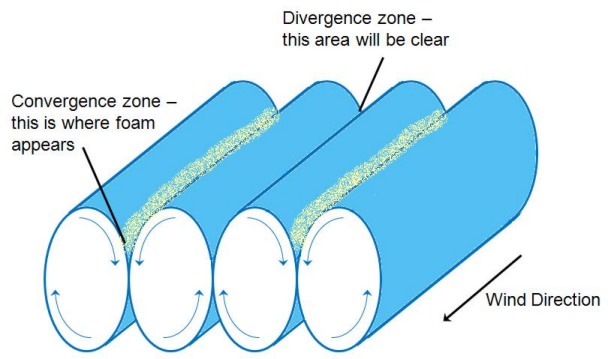Foam On The Water
Does foam on the shore indicate detergent pollution or poor water quality?
The short answer is no, not usually. Generally, foam on the open waters of Severn Sound or in local streams is caused by natural phenomena unless it has a perfume smell typical of many synthetic soaps and detergents. Natural materials occurring in water (from aquatic plants and animals) or leached from the soil have the ability to produce foam.
Foam is created when the surface tension of water is reduced and air is mixed in, causing bubble formation. Many substances, called surfactants, will reduce surface tension, and can be found in both plant and animal material, in addition to soaps and detergents.
“Soap” is defined as compounds of fats, fatty acids, and caustic soda. By reducing the surface tension of water, these materials increase cleansing ability and produce foam. “Detergent” refers to synthetic compounds which also work by reducing surface tension, but have the added properties of softening water and emulsifying (or mixing with) oils. Neither of these cleaning agents should be used where they will directly enter the water. While they are biodegradable, it is the bacteria in soil, not water, which break them down.
As wind or currents stir the water of a lake or river, foam is produced and may accumulate on windward shores in bays or in stream eddies. When aquatic organisms (such as algae and aquatic plants) die and decompose, a variety of organic compounds are released. These act as surfactants, and if sufficiently aerated, can produce foam. Organic compounds leached from soil can also cause foam.
Why do I see streaks of foam in the water?
On windy days, foam tends to accumulate in lines parallel with the direction of prevailing winds. The stronger the wind, the farther apart the lines are. These lines show the convergence of cylindrical counter-rotating underwater currents called Langmuir cells. Debris becomes trapped in the convergence zone, and foam is produced. This can be seen on the surface of Severn Sound, as well as smaller inland lakes such as Orr Lake.

How can I tell the difference between natural and non-natural foam?
Natural foam has an earthy or fishy aroma, and breaks apart easily when disturbed. Foam from silt or erosion is usually a dirty brown color. This type of foam is often seen in the early morning hours and is gone by midday. If the source of foam is detergent pollution, it will be localized to the source of the discharge. It will also have a noticeable perfume smell, and will tend to re-clump when disturbed.

References:
– Mackie, G. 2002. Applied Ecosystem Concepts. Kendall Hutt Publishing Co. Iowa.pp 744.
– Foam – A cause for concern? 1979 (spring issue). Maine Fish and Wildlife. Maine Department of Inland Fisheries and Wildlife, Public Information and Education Division.
– Schmitt, C. 2005. Field Guide to Aquatic Phenomena.USGS Water Resources Resources Institute. pp 6.

